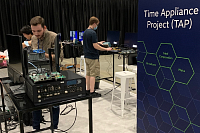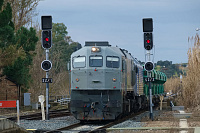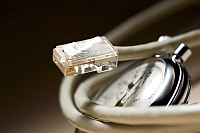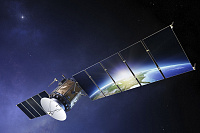07/01/2018
ITU-Tは最近、ネットワークのバウンダリクロックのパフォーマンス規格を定めるG.8273.2の改訂版を発表しました。この改訂版では、オリジナルのクラスAおよびBに加え、新たに高精度クロックのクラスCおよびDが追加されました。新しいクロックは、特に5Gにおいて非常に厳しいタイミング要件を持つ新しいフロントホールネットワークで使用することを目的としています。最も正確なクラスDクロックについては、クロックのパフォーマンスの定義方法が変更されています。このブログでは、なぜこの変更が行われたのか、そしてその意味について説明します。
G.8273.2のバウンダリークロックは、前のクロックから時間を受信し、入力のノイズを平滑化(すなわち、ローパスフィルターとして機能)し、よりクリーンなバージョンのクロックを送信します。したがって、クロックのチェーンを通じて伝わるノイズの量に関しては、低周波ノイズ(または「ワンダー」)のみがチェーンに蓄積されます。高周波ノイズ(または "ジッター")は、チェーンの各クロックによってフィルタリングされます。G.8273.2クロックのフィルターの帯域幅は0.05~0.1Hzと定義されています。
G.8273.2の開発中、クロックには定数時間誤差(cTE)とローパスフィルターをかけた動的時間誤差(dTEL)という2つのパラメータを持たせることが最初に提案されました。この2つのパラメータは、チェーンに沿って蓄積されるノイズの量を示しています。大まかに言えば、クロックによって発生するノイズはcTE±(dTEL/2)となります。2で割っているのは、dTELがピーク・ツー・ピーク限界値として規定されているためです(MTIEは基本的に、時間の経過に伴うピーク・ツー・ピークのふらつきです)。
最大時間誤差(max |TE|)はもともと許容限界として導入されました。これは、パラメータがcTEとdTELのみの場合、クロックの出力における高周波ノイズの量に制限がなくなるためです。この高周波ノイズ(ジッター)は、チェーンの次のクロックの許容範囲を超える可能性があります。したがって、max |TE| が導入されてそれを制限することになりました。"なぜ高周波のdTEパラメータを使ってこれを制御しないのか(dTEH)"と聞かれるかもしれません。その答えは、最初に公開されたG.8273.2のバージョン(2014 年 5 月)にはdTEHパラメータが存在しなかったが、これはすぐに改正案 1(2015 年 1 月)で修正されたということです。
クラスAおよびクラスBのクロックでは、max |TE|はそれぞれ100nsおよび70nsとかなり高く設定されていました。 PTPインターフェースは、量子化誤差や解像度などのさまざまな理由から、常にかなりの高周波ノイズを含んでいます。特に1Gのような低いイーサネットレートでは顕著です。これらはチェーン下の累積ノイズに影響を与えないため、厳密にする必要はありませんでした。クラスCおよびクラスDのクロックについては、新しい指標 max |TEL|、すなわちmax |TE|のローパスフィルターバージョンを使用することが提案されました。これにはいくつかの理由があります:
-
人々は max |TE|の本来の理由であるノイズ耐性を忘れ、不必要に厳しい値を提案していました。
-
dTEHは高周波成分をコントロールするために導入されたものであり、max |TE| はもはや必要ありません。
-
max |TE| のようなフィルタリングされていない測定値では、1つの悪いポイントの測定結果が全体の測定値を制限値不合格にしてしまいます。これは、制限値が高いクラスAやクラスBではそれほど問題にはなりませんでしたが、クラスCやクラスDで提案されているmax |TE|に対する非常に厳しい制限値では大きな問題になってしまいました。
-
クラスDの5nsの仕様を望んでいるオペレーターがいました。その数値は雑音の蓄積に基づいたものでしたが、max |TE|は適切なパラメーターではありませんでした。最大|TEL|は、チェーンに沿って蓄積する雑音の量を示すため、より適切なパラメーターでした。そのため、フィルタリングされたバージョンのmax|TEL|を使うことで、5nsの仕様を達成することができたのです。
一部の参加者は、クラスCに対してmax |TEL|の使用に反対し、クラスAおよびクラスBで使用されたのと同じ方法論を継続したいと考えました。彼らは、max |TEL|は全体のストーリーを伝えていないと主張しました。なぜなら、異なるコンポーネントは異なる方法で加算されるからです。cTEは線形に加算される傾向があり、dTELはRMS 和として加算されます。この2つを1つのパラメータにまとめると、その情報が失われます。したがって、クラスCには既存のパフォーマンス指標を引き続き使用し、クラスDには新しいmax |TEL|パラメータを使用することが合意されました。クラスDのmax |TEL|が5nsに設定されると、数値が線形に加算されるか、別々のコンポーネントに分けて別々に加算されるかはほとんど違いがありません。
これが新しいクロック性能仕様の背景でした。
以下は、私が最近答えた関連Q&Aです:
Q: なぜクラスDはローパスフィルターを必要とするのですか?クラスDがここでフィルターを持つことが重要なのはなぜですか?
Max |TEL| は、チェーン下に蓄積されるノイズの量を示します。次に、ベンダーが5nsのフィルタリングされていない最大 |TE| 仕様を達成することは難しいでしょう。なぜなら、PTPはかなり大きな高周波ノイズを生成する傾向があるからです。
Q:クラスDにもcTE、dTE、MTIE/TDEVの仕様があるのでしょうか?
可能ですが、これらは「for further study」としてマークされています。しかし、実際には、5nsを満たすのが十分に難しいため、これらが合意されるとは思いません。もし制限が3nsのcTEと2nsのdTELに設定されたらどうなるでしょうか?もしベンダーが5nsの最大|TEL|を達成したが、cTEが4nsでdTELが1nsだった場合、クロックは正常に動作しないということになりますか?ルールによれば、クロックは非準拠となりますが、実際のアプリケーションではほぼ確実に正常に動作するでしょう。したがって、実際には、どのベンダーも5nsの制限をさらに細分化することには合意しないと予想しています。
クラスCおよびDのクロックについて、これらの仕様はノイズ発生に関するものです。ノイズ耐性/転送/過渡応答/ホールドオーバーについてはどうですか?
-
クラスCおよびクラスDのノイズ耐性は、現在さらなる研究が必要であり、クラスCおよびクラスDクロックのチェーンに対するネットワーク制限はまだ合意されていません。
-
クラスCおよびDのノイズ転送(PTPからPTP/1ppsへ)はクラスAおよびBと同じです。クラスCおよびDのクロックの帯域幅が同じであるためです。
-
クラスCとDのノイズ転送(SyncEからPTP/1pps)はクラスAとBと同様です。違いは、クラスCとDのクロックには通常のEECではなく、エンハンスドEECが含まれていることです。エンハンスドEECの帯域幅は1〜3Hzですが、通常のEECは1〜10Hzです。これにより、SyncEからT-BCのPTPへのノイズ転送に影響があります。
-
過渡応答とホールドオーバーについては、現在さらなる研究が必要です。今後の会議で何らかの提案がなされることを期待していますが、現在議論されている提案はありません。
関連リンク



































































